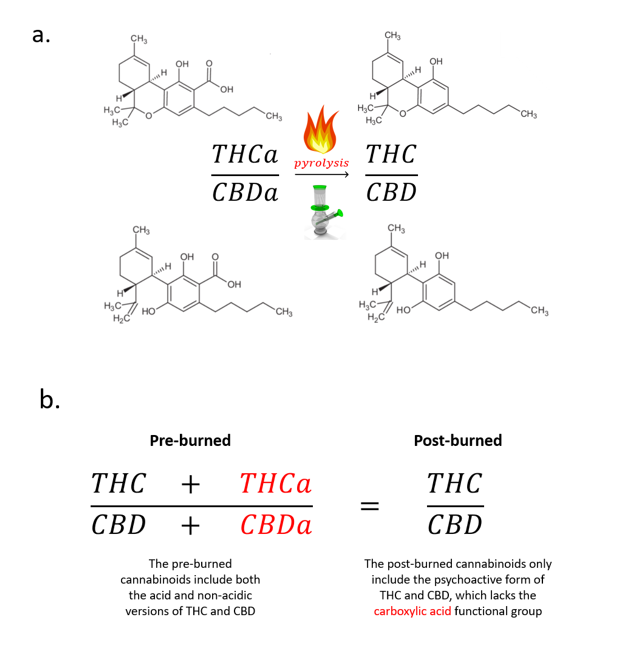Credit for featured photo: Heather Cassano from flicker
For nearly a decade, the legalization of different types of cannabinoids has been increasingly popular international trend. This has made cannabinoids of great interest to both legislature and law enforcement. The cannabinoid that we tend to focus on the most is THC (Δ-9-tetrahydrocannabinol), the main component of marijuana responsible for its psychoactive or mind-altering effects. Another cannabinoid of interest is cannabidiol (CBD), a non-psychoactive component of marijuana which has become popular due to its therapeutic use. Although these cannabinoids have different effects on the body, they have very similar chemical structures, making it possible for certain analytical techniques to confuse the two.
As the increased legalization of these cannabinoids makes them a growing part of our reality, law enforcement must be able to identify and differentiate these cannabinoids pre- and post-smoking. The most common and accurate methods for achieving these tasks are high-performance liquid chromatography (HPLC) and gas chromatography (GC). While these methods are very reliable, they are not easily portable due to large instrumentation (Figure 1). Recently, efforts to fulfill the need for on-the-spot, rapid, and low-cost analysis methods have been investigated, such as smaller GC devices.

Another method under consideration to differentiate cannabinoids involves Fast Blue BB (FBBB). This small, chromogenic (color producing) molecule reacts with cannabinoids using colorimetric tests. While currently used by law enforcement, it has low specificity due to the optical nature of the test. However, FBBB’s color change in the presence of various cannabinoids implies there is an energydifference between the free FBBB (blue color) and the different resultant complexes (red, orange or purple). For this reason, scientists hypothesized that organic thin-film transistors (OTFTs) can be used as a sensor to detect different cannabinoids.
OTFTs contain a dielectric layer sandwiched between organic semi-conducting material and react to changes in current i.e. more or less electrons. As colored complexes are usually more conjugated bond systems that allow lower levels of light to be absorb, the formation of cannabinoid-FBBB complexes would alter the current of the OTFTs and be easily recorded by the transistor. Ideally, OTFTs are low-cost, disposable, and mechanically robust; they have previously been used to detect various medically relevant fluids and environmental gasses.
Dr. Adam Shuhendler from the University of Ottawa created FBBB-sensitized OTFTs to rapidly sense various cannabinoids, particularly CBD and THC, pre and post-pyrolysis (burning). In addition, they assessed if their device could also detect THC and CBD vapors, as detecting these vapors in a vehicle is of interest to law enforcement.
The researchers outfitted the OTFT device with a thin film of FBBB on top of two different kinds of semiconducting layers, one copper based (CuPc) and the other fluorinated copper (F16-CuPc). Then they assessed the performance of the device under ambient conditions to reflect those for which cannabinoid samples would likely be tested. This device distinguished between FBBB and FBBB-cannabinoid complexes from their different conductivities (Figure 2Aii and 2Bii); the FBBB had a larger current and voltage than the cannabinoid-FBBB complexes. The research team then prepared solutions of THC and CBD in 1:3, 1:1 and 3:1 ratios to assess if the device could predict the ratio of THC and CBD (Figure 2Ai and 2Bi).

Pre-burnt THC and CBD samples, however, are in their non-psychoactive carboxylic acid form prior to being burned. While THC and CBD are chemically different from their carboxylic acid form, the device could not distinguish between the non-psychoactive and psychoactive form, detecting THCa as THC and CBDa as CBD while still differentiating THC from CBD (Figure 3). Thus, the ratio of THC and THCa to CBD and CBDa prior to pyrolysis could be used to predict the ratio of THC to CBD post-pyrolysis (Figure 3A).

After analyzing neat standards, the researchers then tested pre- and post-pyrolyzed sample detection with a real-world Cannabis plant sample (Figure 4a). The device was able to detect THC and CBD and determine the ratio of the two in the real-world sample, with error ranges comparable to that of the traditional method HPLC (Figure 4b). The team also determined that the OTFT-FBBB device can detect THC and CBD vapors even in the presence of other vapors such as cigarette smoke.

The results of the device are promising. Such a method could allow for on-the-spot cannabinoid detection by law enforcement that is compact, low-cost, simple, rapid, and capable of analyzing liquids and vapors. Even more impressive is that it cannot only detect cannabinoids but differentiate between THC and CBD. Due to the difference in their legal standing, such a feature could be very important. The researchers have demonstrated how OTFTs have potential for cannabinoid sensing, however they point out the need for engineering of the device in order to improve sensitivity as well as allow for quantitation.
| Title | On-the-Spot Detection and Speciation of Cannabinoids Using Organic Thin-Film Transistors |
| Authors | Zachary J. Comeau, Nicholas T. Boileau, Tiah Lee, Owen A. Melville, Nicole A. Rice, Yen Troung, Cory S. Harris, Benoît H. Lessard, and Adam J. Shuhendler |
| Journal | ACS Sensors |
| Year | 2019 |
| Link | https://pubs.acs.org/doi/10.1021/acssensors.9b01150 |
| Citation | Comeau, Zachary J; Boileau, Nicholas T; Lee, Tiah; Melville, Owen A.; Rice, Nicole A.; Troung, Yen; Harris, Cory S.; Lessard, Benoît H.; Shuhendle, Adam J.; On-the-Spot Detection and Speciation of Cannabinoids Using Organic Thin-Film Transistors. ACS Sens. 2019, 4, 10, 2706-2715 |
